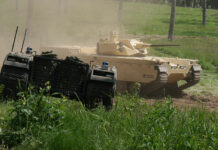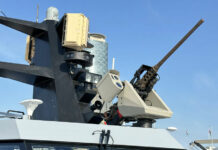The reasons behind the volley of rebukes against Bashar Assad, by the US administration are based, not only on Damascus becoming a haven to Iraqi top official refugees, but on solid intelligence, which focuses on Syria’s missile and chemical warfare arsenal.
Although this information is not new, the timing for action to contain Sysia’s continued efforts in this direction, seems to be right, with the Iraqi campaign being in its final operational stages. Syria’s involvement in Operation Desert Storm 1991 had provided its military leaders with an excellent opporunity to study the highly lethal effect of modern weapons, in comparison to the ex-Soviet materiel, which made up the majority of Syria’s military arsenal. One of the first lessons was the recognition, that a new strategy would be needed to overcome the Israeli air superiority, which had sofar, in all the previous conflicts, prevented any Arab penetration into its airspace.
Counter-balancing Israeli airpower thus received top priority in Syrian’s strategic armament program.
Aided by foreign military and scientific advisors, Syria invested huge financial resources in building an impressive ballistic missile force, and at the same time, went one step further in developing strategic capabilities through chemical weapons grade material, which could be mounted on missile warheads, thus becoming an antidote to Israel’s nuclear potential, to which Syria has felt intimidated for decades.
The Syrian Missile Command is located in Aleppo and controls three mobile surface-to-surface brigades, each including one battalion of FROG-7 ( range:70 km- payload:400 kg), one battalion of SS-21 Scarab Short Range Solid Fuel Ballistic Missiles ( 120 km-120 kg) and one battalion of SCUD-B ( 300 km-985 kg) liquid-fuel ballistic missiles.
To enhance its strategic capability, Syria has acquired an uncertain number of North Korean versions of the Russian Scud-C SSM ( range:-500 km payload: 500 kg) and intelligence reports indicate local production/ assembly facilities of this missile identified near Aleppo and Hamah. (*)
The basic Syrian Scud unit is generally consisting of 18 launchers and 50 missiles.
In September 2000 Syria tested a North Korean version of the Scud-D SSM ( range:-700 km, payload:-400 kg?). The Israeli Arrow 2 Green Pine radar picked up the launch immediately and tracked its trajectory along several hundred kilometers until impact somwehere in the Syrian desert. It was the first indication that Syria had acquired such a long range missile.
An unspecified number of Scud C/D missiles ( some suspected mounting Chemical warheads) are coming under direct control of the presidential palace in Damascus and could be used as a first-strike assault.
The Syrian missile strike capability has been significantly enhanced through an ambitious underground shelter program, which includes hardened concrete silos in a network of subterranean tunnels built with Chinese and North Korean construction assistance.
Two of these facilities have been under satellite observation for years, following the construction progress closely.
In September 1997 an American researcher specialising in satellite interpretation, named Harold Hough identified a Syrian missile site, which indicated Scud-C presence with 36 launchers, protected by concrete berms. The site was located about 25 km from Hama. A year later, during the mounting tension with Israel, reports mentioned Syrian missile units redeploying to a location near Damascus. The Al-Safir complex, in northern Syria, close to the Turkish border, is a huge site of underground bunkers and tunnel networks, extending to over a wast highly top secret area, its perimeter well protected and guarded by sophisticated electronic surveillance equipment. In a series of satellite images, the site and its specific installations can be visited through: http/www.globalsecurity.org/wmd/world/syria/al-safir.htm. A closer look on this site reveals a Scud base protected by SA-2 air defence missile batteries, clearly visible are the SAM battery protective berms, munition storage bunkers and the control center complete with the Fan-Song radar control vans.
But there is more!
A high-voltage sub-station indicates that there is a lot going on at this highly protected secret site, which appears on no official Syrian map. A normal storage facility would not require a large volume of electricity for its routine function. This one, at Al-Safir includes not only a powerful electric supply station, but also forced cooling towers indicating industrial process usually found at plants requiring disposal of waste heat. Chemical process for nerve agents produce such highly unstable intermediates that react explosively when mixed with water. Steam-heating and water cooling must be replaced with special heat-exchange fluids and heating oils that require constant cooling process, rather than normal steam vents to dispose the waste heat.
Between 1995 and 2002, during which the site was under satellite photo surveillance an additional underground facility was built for suspected Scud-D missiles. The large buildings measured 30×130 m. A new command and control facility, located near the tunnel entrances was also sighted. The tunnel entrances are of especial interest. Protected by concrete walls against direct attack with precision munitions, each of the portals are wide enough to accomodate the Russian-built MAZ-543 Transporter for the Scud missile, which can rapidly move in and out at minimum time.
However, there is a technical snag, which, at least sofar, makes this site highly vulnerable to air attack:
As the Syrian missile arsenal is still consisting of liquid fueled versions, the preparatory launching process takes about 90 minutes for the first launch, which is crucial, if the location is under constant satellite surveillance. Moreover, the entire process must be performed outside the underground shelter, as the fuel liquid is highly toxic to the handling crew, which must also wear cumbersome protective gear, rendering the process difficult under adverse climatic conditions. This period, in which the launching process is not only highly vulnerable to attack, but can also become highly lethal if chemical weapons grade material is loaded into the missile warhead. Precisely due to this operational deficiency, the Syrians aim to achieve solid fuel capability, but this requires sophisticated technologies, which cannot easily be obtained if a national scientific infrastructure is not present.
Thus, as long as this technology is not available, analysts assume, that the Syrian missile threat to Israel is moderate, or at least highly vulnerable for attempting a surprise attack, based on the constant high alert status of the Israeli air force and its sophisticated electronic intelligence monitoring systems and ever vigilant satellite surveillance, which can render real-time early warning directing a devastating pre-emptive precision strike on known missile sites, or operational redployments to alternative locations.
(*) Deliveries of Scud-C/D from North Korea to Syria
March 1991- 24 Scud-C + 20 TEL paid US$ 250 mio (approx)
April 1991- 60 ” 12 ” ” US$ 500 mio
May 1991- 36 ” ?
1992- 24 ” assembly equipment
1993- ? ” +7 MAZ-543 by Russian Condor to Damascus Int Airport
1994- ? unspecified number of Scud-C cluster warheads
1995- 26 ” via Bandar Abas (Iran)
2000- ? Scud-D
2000- 50? Nodong missiles + 7 TEL US$ 600 mio ( paid Libya, Iraq?)
Updated 21 January 2003 by NTI
















